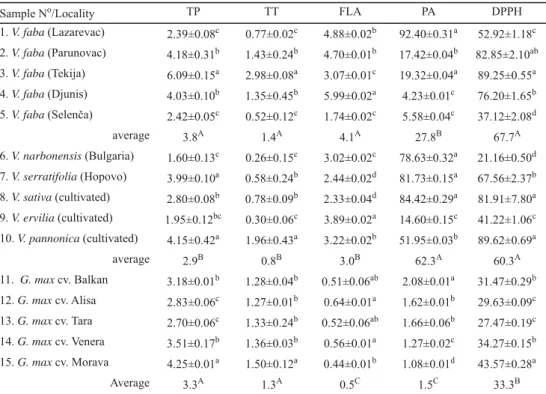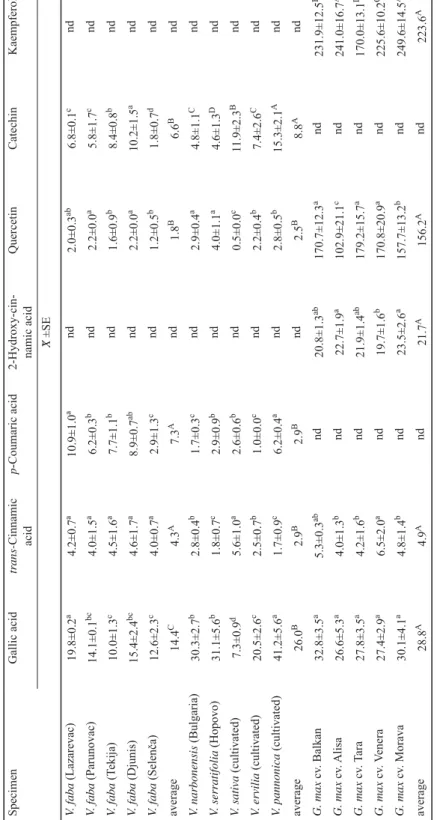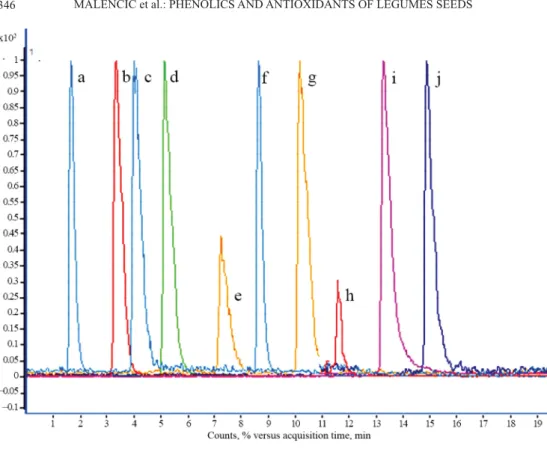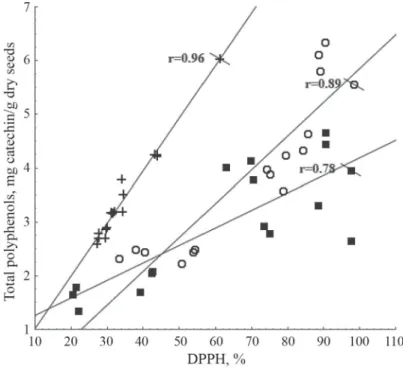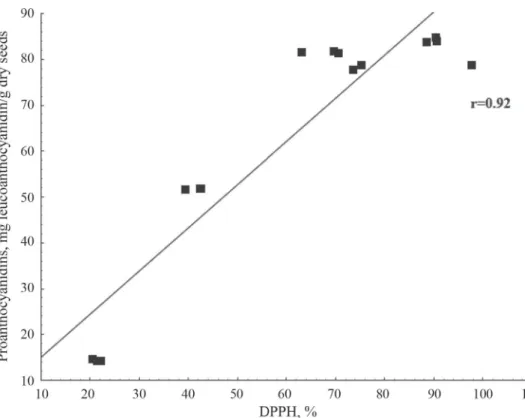DOI: 10.1556/066.2018.47.3.10
DIETARY PHENOLICS AND ANTIOXIDANT CAPACITY OF SELECTED LEGUMES SEEDS FROM THE CENTRAL BALKANS
Đ. MALENČIĆa*, B. KIPROVSKIb, V. BURSIĆa, G. VUKOVIĆc, B. ĆUPINAa and A. MIKIĆb aFaculty of Agriculture, University of Novi Sad, Trg Dositeja Obradovića 8, 21000 Novi Sad, Serbia
bInstitute of Field and Vegetable Crops, Maksima Gorkog 30, 21000 Novi Sad. Serbia
cInstitute of Public Health of Belgrade, Bulevar Despota Stefana 54, 11000 Belgrade. Serbia (Received: 2 November 2017; accepted: 17 February 2018)
The aim of this study was to select Vicia genotypes with higher polyphenol contents and increased antioxidant activity, and to compare them with soybean, the most widespread and utilized legume species grown in the region.
The examined legumes showed similar contents of total polyphenolics and tannins in between specimen, but differed greatly in their fl avonoids and proanthocynidins levels. The content of total polyphenols ranged from 1.6 to 6.09 catechin/g dry seeds, and tannins from 0.26 to 2.98 mg of catechin/g dry seeds. The fl avonoids levels in Vicia species were much higher compared with soybean, while the content of proanthocyanidins ranged from 1.5 (in soybean) to 62.3 mg of leucoanthocyanidin/g dry seeds (in vetches). The gallic and trans-cinnamic acids were identifi ed as major monomeric phenolic compounds, and quercetin among fl avonoids was found in all specimens. Catechin was detected in faba bean and vetches but not in the soybean. The values of the DPPH-test varied in a range between 21.1 and 89.6% of neutralized radicals, which correlated with the total polyphenolics and tannin contents. The faba bean specimens showed favourable traits – high total polyphenolic, fl avonoid and proanthocyanidin contents, low total tannin content, and high DPPH-radical scavenging ability.
Keywords: faba bean, vetches, soybean, plant phenolics, antioxidant activity, functional food
Legumes (Fabaceae) represent one of the most widely distributed plant families in the Balkans (Southeast Europe). The local wild and agricultural fl ora in the Balkan countries and other Eastern European regions are rather rich in legume species. Among these are faba bean (Vicia faba L.), vetches (Vicia spp.), vetchlings (Lathyrus spp.), lentil (Lens culinaris), pea (Pisum sativum L.), chickpea (Cicer arietinum), lupins (Lupinus spp.), and Phaseolus beans (MIKIĆ et al., 2011). On the other hand, soybean (Glycine max L.), pea, lentil, and Phaseolus beans are the typical representatives of agricultural fl ora, where they play an important role in human and animal nutrition and are the main sources of plant proteins. Many of these species have become underutilized and nearly forgotten crops, as in most parts of Southeast Europe soybean and Phaseolus bean are more favoured, as those are are easier to be fi tted in modern crop rotations (MIHAILOVIĆ et al., 2010). Other species such as vetches and vetchlings also remain a part of wild fl ora despite their great agronomic potential with unexplored agronomic properties and non-defi ned role in natural grassland systems (MIKIĆ et al., 2009).
Faba bean seeds supply protein-rich feed stuff and provide a valuable composition with a useful balance of carbohydrate, fi bre, micronutrient, and phytochemicals. However, faba bean contains anti-nutritive compounds, which limit its use in feed and food systems, with unhealthy impact on humans and several animals, such as tannins, vicine, and convicine.
* To whom correspondence should be addressed.
Phone: +381214853401; e-mail: malencic@polj.uns.ac.rs
Tannins are considered to be the main factor of low faba bean protein digestibility (PUSPITASARI, 2017).
In the last decade, functional foods have been a developing area of food science research.
Many foods are derived from plants that naturally contain compounds benefi cial to human health and can prevent certain diseases. This has led to the creation of functional foods to target health problems such as obesity and infl ammation. These plant compounds may possess key benefi cial properties including antioxidant activity, anti-infl ammation activity, cholesterol lowering ability, and even anticancer activity (EMMONS & PETERSON, 2001).
Polyphenols have also been reported to possess antibacterial, antimutagenic, anti- infl ammatory, and vasodilatory properties (AMIDŽIĆ-KLARIĆ et al., 2011). Phenolics may act as antioxidants, thereby reducing the risk of atherosclerosis and coronary heart disease, which can be caused by the oxidation of low-density lipoproteins (MALENČIĆ et al., 2007). For these reasons, polyphenol-enriched foods would be classifi ed as functional foods. The positive effects of legume seeds and their possible health benefi ts in human nutrition have commanded considerable attention. In human studies it has been demonstrated that V. faba protein has hypocholesterolemic effect, comparable to that of soybean protein (GOYOAGA et al., 2011).
Since there is a lack of lietrature, our goal was to contribute to possible benefi tial feed and food properties of these underutilized legumes grown in the Balkans.
1. Materials and methods
1.1. Plant materials and chemicals
Five samples of seeds of faba bean (Vicia faba L.) and 5 samples of vetches [Vicia narbonensis L., V. serratifolia Jacq., V. sativa L., V. ervilia (L.) Wild., and V. pannonica Crantz] were analysed and compared with 5 commercially grown soybean cultivars (Balkan, Alisa, Tara, Venera and Morava). The specimen of faba beans and two vetches (V. serratifolia and V.
narbonensis) were collected in the summer of 2015, from the local autochthonous populations from different localities in Serbia – V. faba from Lazarevac (44°21’N, 20°14’E), Parunovac (43°33’N, 21°22E), Tekija (44°39’N 22°20’E), Djunis (43°34’N, 21°31’E), and Selenča (45°24’N, 19°15’E); V. narbonensis from Pirot, 43°10’N, 22°32’E); V. serratifolia from Hopovo, 45°07’N, 19°50’E), and one from western Bulgaria (Dolni Lom, 43°30’N, 22°47’E).
Other vetches and soybean cultivars were grown and collected in the same period, on the experimental fi elds at Rimski Šančevi, near Novi Sad, Serbia (45°33′N, 19°85′E).
Acetone, formic acid, acetic acid, and EtOH (pa) were purchased from Zorka pharma (Šabac, Serbia); Folin-Ciocalteu reagent, PVPP, and DPPH from Sigma-Aldrich Co. (St.
Louis, MO, USA); Na2CO3, AlCl3 reagent, and 2% ferric reagent from Centrohem (Belgrade, Serbia); butanol-HCl assay and methanol (HPLC grade) from Merck (Darmstadt, Germany- Fisher Chemical, Loughborough, UK).
1.2. Preparation of extracts
The plant material (1 g of whole seeds) was ground in a mill, reduced to a fi ne powder, and extracted with 70% aqueous acetone (50 ml) by sonication for 20 min in an ultrasonic bath at ambient temperature. The extracts were rapidly vacuum-fi ltered through a sintered glass funnel and kept refrigerated before assay.
342
1.3. Determination of total polyphenols (TP)
Aliquots (0.1 ml) of aqueous acetone extracts were transferred into test tubes and mixed well with Folin-Ciocalteu reagent (0.5 ml). After 6 min, 0.4 ml of saturated sodium carbonate solution (177 g Na2CO3/l) was added and vortexed (HAGERMANN et al., 2000). After 120 min, the absorbance (A) of the resulting blue colored mixtures was recorded at 725 nm against a blank. The amount of TP was calculated as a catechin equivalent and expressed as mg of catechin/g dry seeds.
1.4. Determination of total tannins (TT)
TT content was determined by the Folin-Ciocalteu procedure as described above (HAGERMANN
et al., 2000), after the removal of tannins by adsorption on an insoluble matrix (polyvinylpolypyrrolidone, PVPP). The insoluble, cross-linked PVPP (100 mg) was weighed into test tubes and extracts (1 ml) were added. After 15 min at 4 °C, the tubes were vortexed and centrifuged for 10 min at 4350 g. Aliquots (0.2 ml) were transferred into test tubes and nonabsorbed phenolics were determined as described. The calculated values were subtracted from the total phenolic contents and total tannin contents expressed as mg of catechin/g dry seeds.
1.5. Determination of fl avonoids (FLA)
The total fl avonoids were determined after the extraction of plant material (1 g of whole seeds) with 20 ml of methanol–water–acetic acid (140:50:10 v/v) as extracting solvent for 60 min (MARKHAM, 1989). Aliquots (2.5 ml) were transferred into 50 ml volumetric fl asks and made up with water. To each 10 ml of analysis solution, water (2 ml) and AlCl3 reagent (5 ml) were added, and the A was recorded at 430 nm against a blank. The amount of FLA was calculated as a rutin equivalent from the calibration curve of rutin standard solutions, and expressed as mg rutin/g dry seeds.
1.6. Determination of proanthocyanidins (PA)
PAs were determined by a butanol-HCl assay (MARKHAM, 1989). In brief, aliquots of the prepared extracts (0.5 ml) were transferred into test tubes. After the addition of butanol-HCl reagent (95:5 butanol-HCl, 3.0 ml) and 2% ferric reagent (0.1 ml), the test tubes were vortexed and placed in a boiling water-bath for 60 min. After cooling, the A values were recorded at 550 nm against a blank. PAs were expressed as mg leucoanthocyanidin/g of dry seeds, assuming that the specifi c A value of leucoanthocyanidin was 460 nm.
1.7. Determination of free radical scavenging activity (DPPH)
1,1-diphenyl-2-picrylhydrazyl (DPPH) free radical scavenging activity was assayed according to WASHIDA and co-workers (2007). One millilitre of the absolute EtOH solution of the sample (1:10, w/V) was mixed with a 0.5 mmol DPPH EtOH solution (0.5 ml) and 0.1 mol acetate buffer (pH 5.5, 1.0 ml). After 30 min, the A value of the mixture at 517 nm was measured against a blank containing absolute EtOH (0.5 ml) instead of a sample aliquot.
DPPH-radical scavenging activity was expressed as % of the neutralised free radicals, assuming that the sample with the higher percentage has higher scavenging capacity. The radical scavenging capacity (RSC) percentage was calculated using the formula: RSC=100–
100×Aextract/Ablank, where Aextract represents absorbance of the analysed sample extract and Ablank represents absorbance of blank sample.
1.8. Determination of phenolic acids and fl avonoids (FLA)
The extraction of phenolic compounds for HPLC analysis of phenolic acids and FLA was carried out from 0.5 g of the sample with the addition of EtOH (10 ml) at constant 60 ºC (GENERALIĆ et al., 2012). The phenolic acids analysis was carried out in negative electrospray ionization (ESI) mode. An Agilent 1200 (Agilent Technologies, USA) system with a binary pump was used. This was equipped with a reversed-phase C18 analytical column of 50×4.6 mm and 1.8 μm particle size (Agilent Zorbax Eclipse XDBC18). Mobile phase was 0.1%
formic acid in methanol (solvent A) and 0.1% formic acid in Milli-Q water (solvent B). The gradient was 0 min (80% B), 10 min (50% B), 20 min (5% B), 24 min (0% B), 25 min (80%
B), with the fl ow rate of 0.6 ml min–1. The mass analysis was carried out with an Agilent 6410B Triple Quadrupole mass spectrometer equipped with multi-mode ion source (MMI) in MRM mode. The data acquisition and quantifi cation were conducted using MassHunter Workstation software B.06.00. The following ionization conditions were used: drying gas (nitrogen) temperature 325 °C, vaporizer 200 °C, drying gas fl ow rate 5 l min–1, nebulizer pressure 40 psi, and capillary voltage 2500 V.
1.9. Statistic analysis
Values of the biochemical parameters were expressed as average values () ±standard error (SE) of the determinations made in triplicates and tested by ANOVA followed by the comparisons of means by Duncan’s multiple range test (P<0.05). The stepwise multiple linear regression analysis was used to test the correlation between antioxidant activities and investigated phenolic classes contents and expressed as a correlation coeffi cient (r). The data were analysed using STATISTICA for Windows version 10.0.
2. Results and discussion
The results obtained for phenolic contents and antioxidant activities of legume seed extracts showed great differences not only among different species but also for the specimens of the same group. The highest contents of TP, TT, and FLA, in average, were recorded in faba bean landraces (Table 1).
The contents of TP and TT in soybean cultivars were similar to those in faba beans, and signifi cantly higher compared with vetches specimen. Most of the vetches were signifi cantly poorer in TT, which may recommend them as a good source for ensiled livestock feed in animal husbandry. Low tannin content, especially in protein-rich plants such as legumes, is a favorable trait, because tannins are known to bind to macromolecules (proteins, structural carbohydrates, and starch) and decrease their availability to digestion (ADDISU, 2016), and thus are largely regarded as being anti-nutritional (MAKKAR, 2003). Our results for TP and TT were considerably higher (in average: 3.8 mg g–1 dry seeds in faba beans and 2.9 mg g–1 in dry seeds of vetches) compared with the results of other authors. BAGINSKY and co-workers (2013) reported TP contents in faba beans ranging from 817 to 1337 mg of gallic acid equivalent/kg and TT contents from 309 to 958 mg gallic acid equivalent/kg. The mean levels of PA were 2233 mg kg–1, which is similar to our fi ndings for faba bean landraces.
344
Table 1. Polyphenol contents and antioxidant activity of seed extracts in selected legumes
Sample No/Locality TP TT FLA PA DPPH
1. V. faba (Lazarevac) 2.39±0.08c 0.77±0.02c 4.88±0.02b 92.40±0.31a 52.92±1.18c 2. V. faba (Parunovac) 4.18±0.31b 1.43±0.24b 4.70±0.01b 17.42±0.04b 82.85±2.10ab 3. V. faba (Tekija) 6.09±0.15a 2.98±0.08a 3.07±0.01c 19.32±0.04a 89.25±0.55a 4. V. faba (Djunis) 4.03±0.10b 1.35±0.45b 5.99±0.02a 4.23±0.01c 76.20±1.65b 5. V. faba (Selenča) 2.42±0.05c 0.52±0.12c 1.74±0.02c 5.58±0.04c 37.12±2.08d
average 3.8A 1.4A 4.1A 27.8B 67.7A
6. V. narbonensis (Bulgaria) 1.60±0.13c 0.26±0.15c 3.02±0.02c 78.63±0.32a 21.16±0.50d 7. V. serratifolia (Hopovo) 3.99±0.10a 0.58±0.24b 2.44±0.02d 81.73±0.15a 67.56±2.37b 8. V. sativa (cultivated) 2.80±0.08b 0.78±0.09b 2.33±0.04d 84.42±0.29a 81.91±7.80a 9. V. ervilia (cultivated) 1.95±0.12bc 0.30±0.06c 3.89±0.02a 14.60±0.15c 41.22±1.06c 10. V. pannonica (cultivated) 4.15±0.42a 1.96±0.43a 3.22±0.02b 51.95±0.03b 89.62±0.69a
average 2.9B 0.8B 3.0B 62.3A 60.3A
11. G. max cv. Balkan 3.18±0.01b 1.28±0.04b 0.51±0.06ab 2.08±0.01a 31.47±0.29b 12. G. max cv. Alisa 2.83±0.06c 1.27±0.01b 0.64±0.01a 1.62±0.01b 29.63±0.09c 13. G. max cv. Tara 2.70±0.06c 1.33±0.24b 0.52±0.06ab 1.66±0.06b 27.47±0.19c 14. G. max cv. Venera 3.51±0.17b 1.36±0.03b 0.56±0.01a 1.27±0.02c 34.27±0.15b 15. G. max cv. Morava 4.25±0.01a 1.50±0.12a 0.44±0.01b 1.08±0.01d 43.57±0.28a
Average 3.3A 1.3A 0.5C 1.5C 33.3B
TP: total polyphenols; TT: total tannins; FLA: fl avonoids; PA: proanthocyanidins; DPPH: free radical scavenging activity
The ±SE values marked with the same letter do not differ signifi cantly at (P<0.05), difference among tested groups (uppercase) and within the group (lowercase)
Soybean cultivars were poor in FLA, having 6- to 8-fold lower amount of these substances in their seeds compared to faba beans and vetches. FLA can directly scavenge molecules of active oxygen, including H2O2, 1O2, and O2.-, .OH, etc. They are also effective scavengers of peroxynitrite, a highly reactive oxidant formed when superoxide reacts with NO. (GOULD et al., 2002).
As expected, soybean seeds were also poor in PAs, another product of the FLA pathway, which exist as oligomers of leucoanthocyanidins. In our study, the average content was only 1.5 mg g–1 compared to faba beans – 27.8 mg g–1, and vetches – 62.3 mg g–1. The composition and content of free monomeric phenolic compounds of faba bean, vetches, and soybean seed preparations are presented in Table 2.
Table 2. Phenolic constituents (μg g–1 dry seeds) in seed extracts of selected legumes as estimated by LC-MS/MS SpecimenGallic acidtrans-Cinnamic acidp-Coumaric acid2-Hydroxy-cin- namic acidQuercetinCatechinKaempferol X¯ ±SE V. faba (Lazarevac)19.8±0.2a4.2±0.7a10.9±1.0and2.0±0.3ab6.8±0.1cnd V. faba (Parunovac)14.1±0.1bc4.0±1.5a6.2±0.3bnd2.2±0.0a5.8±1.7cnd V. faba (Tekija)10.0±1.3c4.5±1.6a7.7±1.1bnd1.6±0.9b8.4±0.8bnd V. faba (Djunis)15.4±2.4bc4.6±1.7a8.9±0.7abnd2.2±0.0a10.2±1.5and V. faba (Selenča)12.6±2.3c4.0±0.7a2.9±1.3cnd1.2±0.5b1.8±0.7dnd average14.4C4.3A7.3And1.8B6.6Bnd V. narbonensis (Bulgaria)30.3±2.7b2.8±0.4b1.7±0.3cnd2.9±0.4a4.8±1.1Cnd V. serratifolia (Hopovo)31.1±5.6b1.8±0.7c2.9±0.9bnd4.0±1.1a4.6±1.3Dnd V. sativa (cultivated)7.3±0.9d5.6±1.0a2.6±0.6bnd0.5±0.0c11.9±2.3Bnd V. ervilia (cultivated)20.5±2.6c2.5±0.7b1.0±0.0cnd2.2±0.4b7.4±2.6Cnd V. pannonica (cultivated)41.2±5.6a1.7±0.9c6.2±0.4and2.8±0.5b15.3±2.1And average26.0B2.9B2.9Bnd2.5B8.8And G. max cv. Balkan32.8±3.5a5.3±0.3abnd20.8±1.3ab170.7±12.3and231.9±12.5B G. max cv. Alisa26.6±5.3a4.0±1.3bnd22.7±1.9a102.9±21.1cnd241.0±16.7A G. max cv. Tara27.8±3.5a4.2±1.6bnd21.9±1.4ab179.2±15.7and170.0±13.1D G. max cv. Venera27.4±2.9a6.5±2.0and19.7±1.6b170.8±20.9and225.6±10.2C G. max cv. Morava30.1±4.1a4.8±1.4bnd23.5±2.6a157.7±13.2bnd249.6±14.5A average28.8A4.9And21.7A156.2And223.6A nd: not detected. The ±SEvalues marked with the same letter do not differ signifi cantly at (P<0.05), difference among tested groups (uppercase) and within the group (lowercase)
346
Fig. 1. LC-MS/MS chromatogram of the mixture of phenolic standards (C=1 μg ml)
a: gallic acid; b: (+)-catehin hydrate; c: chlorogenic acid; d: caffeic acid; e: 2-hydroxycinnamic acid; f: p-coumaric acid; g: ferulic acid; h: quercetin; i: trans-cinnamic acid; j: kaempferol
LC-MS/MS chromatogram of the mixture of phenolic standards is shown in Figure 1.
The extracts of landraces and cultivars contained gallic and trans-cinnamic acids as their major phenolic compounds. Cinnamic acid derivatives, such as p-coumaric and ferulic acids, are known to be important components of cell walls of cereals (KAMISAKA et al., 1990). The 2-hydroxycinnamic acid was found only in soybean cultivars, the same as fl avonoid kaempferol. Another fl avonoid, quercetin, was found to be ubiquitous in all legumes investigated, where soybean samples were especially rich in this substance. Catechin was detected in faba bean and vetches, but not in the soybean samples. The fl avonoid aglycones (7,3′,4′-trihydroxyfl avone, 7,4′-dihydroxyfl avone, quercetin, and kaempferol) and fl avonoid glycosides (quercetin 7-glucoside and kaempferol 7-glucoside) were identifi ed from seed exudates of V. faba (HO et al., 2002), which is in agreement with our fi ndings for quercetin, but not for kaempferol. Due to a large amount of FLA and PA found in the seeds of faba bean and vetches, their extracts were more effective at scavenging of DPPH-radicals (67.7%
neutralized DPPH-radicals in faba beans and 60.3% in vetches, in average) compared to soybean seed extracts (33.3%). According to the results of multiple regression analyses, the antioxidant activity of all investigated genotypes positively correlated with the TP content (Fig. 2). Additionally, the antioxidant capacity of faba beans positively correlated with FLA content (Fig. 3), while seed extracts of vetches showed a positive correlation between DPPH- free radical scavenging activity and the PA content (Fig. 4).
Fig. 2. Correlation between DPPH and TP in investigated legumes : Faba bean; : vetches; +: soybean
Fig. 3. Correlation between DPPH and FLA in investigated legumes
348
Fig. 4. Correlation between DPPH and PA in investigated legumes
3. Conclusions
Synergistic effect of phenolic classes seems to be unavoidable when assessing antioxidant capacity of plant extracts. Analyses showed that out of each group some perspective and interesting landraces/cultivars may be selected. From the group of faba beans almost all specimens show favourable traits – high TP, FLA, and PA contents, low TT content, and high DPPH-radical scavenging ability. In the vetches, a great diversity in investigated parameters has been established, but the contents of FLA and PA were signifi cantly higher compared to seeds of commercially grown soybean cultivars. The results suggest that phenolics should be considered as an important feature of Vicia species, as some of its nutritive and pharmacological effects could be attributed to their presence.
*
This research was a part of the project of the South East Europe-Europe Research Area.NET Plus Joint Call
“Sustainable preservation of indigenous South East European legumes and their traditional food and feed products”
(SEEERA PLUS-168). Authors are grateful to the Ministry of Education, Science and Technological development, Republic of Serbia, Grant No. TR-31022.
References
ADDISU, S. (2016): Effect of dietary tannin source feeds on ruminal fermentation and production of cattle; a review.
Online J. Anim. Feed Res., 6, 45–56.
AMIDŽIĆ-KLARIĆ, D., KLARIC, I. & MORNAR, A. (2011): Polyphenol content and antioxidant activity of commercial blackberry wines from Croatia: Application of multivariate analysisfor geographic origin differentiation. J.
Food Nutr. Res., 50, 199–209.
BAGINSKY, C., PENA-NEIRA, A., CACERES, A., HERNANDEZ, T., ESTRELLA, I., MORALES, H. & PERTUZE, R. (2013):
Phenolic compound composition in immature seeds of fava bean (Vicia faba L.) varieties cultivated in Chile.
J. Food Compos. Anal., 31, 1–6.
EMMONS, C.L. & PETERSON, D.M. (2001): Antioxidant activity and phenolic content of oat as affected by cultivar and location. Crop Sci., 41, 1676–1681.
GENERALIĆ, I., SKORZA, D., ŠURJAK, J., MOŽINA, S., LJUBENKOV, I., KATALINIĆ, A., ŠIMAT, V. & KATALINIĆ, V. (2012):
Seasonal variations of phenolic compounds and biological properties in sage (Salvia offi cinalis L.). Chem.
Biodivers., 9, 441–457.
GOYOAGA, C., BURBANO, C., CUADRADO, C., ROMERO, C., GULLAMON, E., VARELA, A., PEDROSA, M.M. & MUZQUIZ, M.
(2011): Content and distribution of protein, sugars and inositol phosphates during the germination and seedling growth of two cultivars of Vicia faba. J. Food Compos. Anal., 24, 391–397.
GOULD, K.S., MCKELVIE, J. & MARKHAM, K.R. (2002): Do anthocyanins function as antioxidants in leaves? Imaging of H2O2 in red and green leaves after mechanical injury. Plant Cell Environ, 25, 1261–1269.
HAGERMANN, A., HARVEY-MULLER, I. & MAKKAR, H.P.S. (2000): Quantifi cation of tannins in tree foliage – A laboratory manual. FAO/IAEA Working Document. International Atomic Energy Agency, Vienna, pp. 4–7.
HO, H.M., CHEN, R.Y., LEUNG, L.K., CHAN, F.L., HUANG, Y. & CHEN, Z.Y. (2002): Difference in fl avonoid and isofl avone profi le between soybean and soy leaf. Biomed. Pharmacother., 56, 289–295.
KAMISAKA, S., TAKEDA, S., TAKAHASHI, K. & SHIBATA, K. (1990): Diferulic and ferulic acid in the cell wall of Avena coleoptiles: Their relationships to mechanical properties of the cell wall. Physiol. Plantarum, 78, 1–7.
MAKKAR, H.P.S. (2003): Quantifi cation of tannins in tree and shrub foliage: A laboratory manual. Kluwer Academic Publishers, 102 pages.
MALENČIĆ, Đ., POPOVIĆ, M. & MILADINOVIĆ, J. (2007): Phenolic content and antioxidant properties of soybean (Glycine max (L.) Merr.) seeds. Molecules, 12, 576–581.
MARKHAM, K.R. (1989): Flavones, fl avonols and their glycosydes. -in: DEY, P.M. & HARBORNE, J.B. (Eds) Methods in plant biochemistry, Vol. 1. Plant phenolics. Academic Press, London, pp. 197–235.
MIHAILOVIĆ, V., MIKIĆ, A., VASIĆ, M., ĆUPINA, B., ĐURIĆ, B., DUC, G., STODDARD, L.F. & HAUPTVOGEL, P. (2010):
Neglected legume crops of Serbia – Faba bean (Vicia faba). Ratarstvo i povrtarstvo – Field Veg. Crops Res., 47, 27–32.
MIKIĆ, A., MIHAILOVIĆ, V., HAUPTVOGEL, P., ĆUPINA, B., PETROVIĆ, M., KRSTIĆ, Đ., JOVIČIĆ, D., MILOŠEVIĆ, B. &
HAUPTVOGEL, R. (2009): Wild population of vetches (Vicia) as forage and green manure crops for temperate regions. Irish J. Agr. Food Res., 48, 265.
MIKIĆ, A., MIHAILOVIĆ, V., ĆUPINA, B., ĐORĐEVIĆ, V., MILIĆ, D., DUC, G., STODDARD, L.F., LEJUNE-HENAUT, I., MARGET, P. & HANOCQ, E. (2011): Achievements in breeding winter-sown annual legumes for temperate regions with emphasis on the continental Balkans. Euphytica, 180, 57–67.
PUSPITASARI, W. (2017): Association analyses to genetically study reproduction and seed quality features of faba bean (Vicia faba L.). Ph.D. Dissertation, Faculty of Agricultural Sciences, Georg-August-University Göttingen, Germany. 86 pages.
WASHIDA, K., ABE, N., SUGIYAMA, Y. & HIROTA, A. (2007): Novel DPPH radical scavengers, demethylbisorbibutenolide and trichopyrone, from a fungus. Biosci. Biotech. Bioch., 71, 1052–1057.
